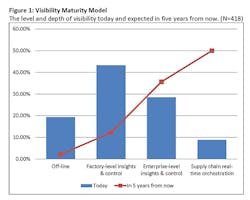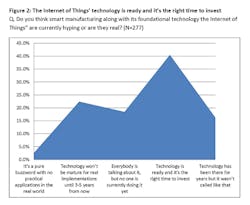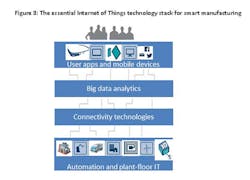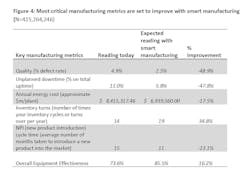The Internet of Things Will Make Manufacturing Smarter
Manufacturing worldwide is on the cusp of a revolution. New information technologies are suddenly offering not only to make the management of manufacturing more effective, as we saw with early versions of plant and enterprise software, but the work itself smarter. Technologies based on the Internet of Things have the potential to radically improve visibility in manufacturing to the point where each unit of production can be “seen” at each step in the production process. Batch-level visibility is being replaced by unit-level visibility. This is the dawn of smart manufacturing.
The transformation that it implies is huge. SCM World’s recent field survey on smart manufacturing and the Internet of Things finds that while one in five today admit their factory operations are offline completely, this will drop to near zero in five years. In fact, according to our Visibility Maturity Model (Figure 1), half of all manufacturing executives surveyed expect to have visibility across the supply chain at this unit level. Only 10% predict they’ll still be limited to single factory-level insights and control—a drop of 75% from today’s state of affairs.
Smart manufacturing is about creating an environment where all available information—from within the plant floor and from along the supply chain—is captured in real-time, made visible and turned into actionable insights. Smart manufacturing comprises all aspects of business, blurring the boundaries among plant operations, supply chain, product design and demand management. Enabling virtual tracking of capital assets, processes, resources and products, smart manufacturing gives enterprises full visibility which in turn supports streamlining business processes and optimizing supply and demand.
In essence, smart manufacturing is a decision-making environment. Very importantly, smart manufacturing includes proactive and autonomic analytics capabilities, making smart manufacturing an intelligent and self-healing environment. With smart manufacturing organizations can predictively meet business needs through intelligent and automated actions driven by previously inaccessible insights from the physical world. Smart manufacturing transforms businesses into proactive, autonomic organizations that predict and fix potentially disruptive issues, evolve operations and delight customers, all while increasing the bottom line.
A number of leading global manufacturers—including the likes of Bosch, Cisco, FCA (Fiat Chrysler Automobiles), GE, General Mills, Harley-Davidson and Siemens—are early adopters of smart manufacturing (or Industrie 4.0) in their plants. Interesting examples include:
Siemens. At Siemens’ electronics manufacturing plant in Amberg, Germany, machines and computers handle 75% of the value chain autonomously, with some 1,000 automation controllers in operation from one end of the production line to the other. Parts being produced communicate with machines by means of a product code, which tells the machines their production requirements and which steps need to be taken next. All processes are optimized for IT control, resulting in a minimal failure rate. Employees are essentially supervising production and technology assets, including handling unexpected incidents.
General Electric. At one of GE’s Durathon battery plants, 10,000+ sensors measure temperature, humidity, air pressure and machine operating data in real time. This not only gives the opportunity to monitor production and adjust processes in real time, but also to trace battery performance back to specific batches of powder and at every step along the process.
Harley-Davidson. Much of the turnaround that Harley-Davidson achieved in rebuilding its major production facility in York, Pa., is due to a dramatic increase in visibility. Every asset on the plant floor is connected and every step in production is tracked and incorporated in a real-time performance management system.
Cisco. To better orchestrate its global network of outsourced production plants, Cisco developed a “virtual” manufacturing execution system platform (VMES), which provides real-time visibility of production operations. The system leverages technologies such as cloud, Big Data analytics and the Internet of things to connect and gather real-time information from production machines, enabling predictive quality capabilities in a fully outsourced manufacturing environment.
Smart manufacturing requires a healthy dose of technology to make sure machines work together, material flows visibly in real time, and teams of knowledge workers orchestrate the entire process. The Internet of Things is the technology environment that makes this possible. In plant floor applications, the Internet of Things can create a network linking a range of manufacturing assets from production equipment to parts being produced, from sensor-embedded automation controls to energy meters, from trucks to a warehouse’s smart shelves.
With the Internet of Things, manufacturers can give each of their physical assets a digital identity that enables them to know the exact location and condition of those assets in real time ubiquitously throughout the supply chain.
The Right Time to Invest
Manufacturers around the world have confidence now. About 40% of survey respondents believe that smart manufacturing along with its foundational technology—the Internet of Things—is ready and that it’s the right time to invest (Figure 2). Only 3% dismiss smart manufacturing and the Internet of Things as pure buzzwords.
Smart manufacturing, for those ready to get started, is essentially a platform that integrates several technologies, such as connectivity technologies (the network that enables things to connect to the Internet), the cloud (the computing and storage environment where assets can communicate) and Big Data analytics (the intelligence of the system that is able to analyze data and provide insights on the fly).
The idea is to use connectivity technologies (e.g., industrial networks, wifi, M2M, etc.) to link factory automation assets (e.g., production equipment, robots, RFID, etc.) to end-user apps (e.g., MES, PLM, ERP, etc.), as well as mobile devices for more active and precise business decision-making. Our essential technology stack for the Internet of Things for smart manufacturing applications is represented in Figure 3.
In our field survey we also asked what performance outcomes were expected with smart manufacturing, and found some very high hopes. Gains in quality, uptime, inventory efficiency and more are expected to be well into double-digit percentages (Figure 4).
The Internet of Things has a catchy ring to it, but for many the possibilities are almost too far-reaching to imagine. When the concept is applied with specific applications in mind, and in particular when wedded to other transformative technologies, its potential becomes clear. For manufacturers the likely impact of IoT in smart manufacturing looks very big indeed.
Kevin O’Marah is chief content officer with SCM World, and Pierfrancesco Manenti is VP of research with SCM World.








